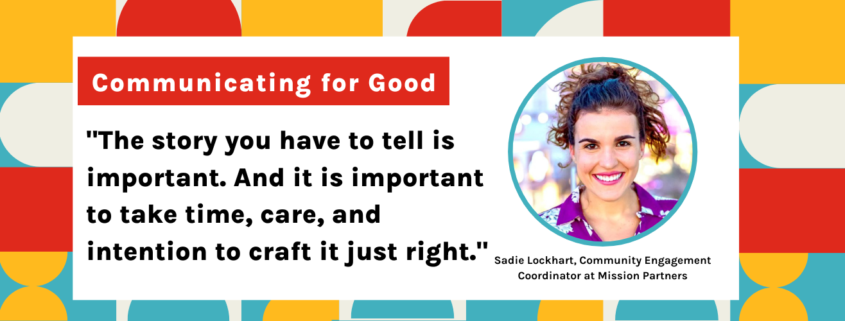SIDEKICKS UNITE! The Power and Impact of Asset-Based Language
Does your organization have an important story to tell, but when you try telling it, you find yourself getting nervous over “getting the words right?”
At Mission Partners, we know the power of story. When told well, stories can sway donors to action, stories can deepen understanding of complex issues, and stories can advance legislation. But stories rely on one important element to be effective: shared language.
There is a story that I’ve been sharing for years, about my experiences working with SHH Kids in Honduras, but the way I tell it has shifted over time, as I’ve learned more about the impact that it can have on a community. I was reminded of the importance of this when I traveled back to Honduras this past June for the first high school graduation of the Villa Soleada Bilingual School. I began traveling to Honduras in college through SHH Kids, an organization that works to alleviate violence and extreme poverty in Honduras through education and youth empowerment. SHH Kids partners with local communities to build schools around rural Honduras. It is Honduran led, and it is funded by college chapters in the U.S. Each year, students travel to Honduras to learn more about the country, meet the people there, and help on the worksite. Over the years, I developed many friendships with the people living in Villa Soleada, which made this graduation day even more special.
When I first began telling the story of my time in Honduras, I sometimes felt nervous over how to tell it. The stakes felt so high because I wanted to represent these incredible humans well, and be able to accurately convey how people could support the organization and its mission.
But then I learned, there was a guide that could support how I talked about my work, and that could support my personal commitment to this community, too. SHH Kids uses Dr. Shawn Humphrey’s Sidekick Manifesto, a guide used in economic development work that leads with the community being the hero of its own story. And we, the ones community adjacent, are merely the sidekicks.
This tool helped me to frame these stories differently because it was common for my friends at home to ask about my experience in Honduras, and expect me to tell a story in a way that made me the center of the story. But the work in Honduras isn’t about me. It’s imperative that I remain far from becoming the main character. But it is important that I share my story because it holds the power to convey an important message to our donors, to combat misinformation in the news, and to support advancing the organization’s mission.
At Mission Partners, we too abide by the “sidekick mentality,” although in different terms. Our first value as a company is steeped in people first, and our approach to storytelling is first grounded in community-led messaging and brand development, which we refer to as asset-based framing. Developed by Trabian Shorters, asset-based framing has been a great complement to my understanding of the sidekick mentality framework. In asset-based framing, we learn to define people by their assets and aspirations before noting the challenges and deficits.
So using asset-based language, here is the story I’ll share with you:
The people I know in Villa Soleada are amazing humans with big smiles, and even bigger hearts. The hard-working graduates who have their sights on college are inspiring. Their laughter echoes through the halls, and they dream about being psychologists, teachers, scientists, and digital marketers. There are important facts to note about Honduras and its systemic challenges. It has a 66% poverty rate and continues to have one of the highest homicide rates in the world. Because of several external factors, 37% of Honduran children of secondary school age are out of school, and that number rises to 62% in the poorest areas. SHH Kids, in partnership with the communities of rural Honduras, believes that access to education is one key way to begin changing those statistics and the broken system.
So pause and take a deep breath. Your turn.
The story you have to tell is important. And it is important to take time, care, and intention to craft it just right.
Here are a few considerations that I have learned for how to apply asset-based framing, through the “sidekick mentality,” to my own social impact work and messaging:
- Ground Messaging in Authenticity: Do the work. Explore opportunities for the community you are working with to be involved in, lead, and be a part of major decisions, when appropriate. And never stop asking, whose voice is being left out?
- Level Up Relationships: Use language such as “working with” or “partnering with” to describe the relationship between your organization and the communities it works with.
- State the Source of the Inequity: Describe and name the systemic inequities as the root of the issue, not the community or individuals themselves.
- Lead With Strengths: From the beginning of your partnership, recognize the strengths and aspirations of the community and individuals. Through your partnership, honor the assets the community already has. The best sidekicks remind the superhero of what makes them great!
Words are powerful, and the way you craft a narrative can mean the difference between communities feeling disempowered, and communities taking the lead for themselves and becoming the hero of their own story.
As I watched the first ever graduates cross the stage, tears of joy streamed down my face for these young people and their bright futures, for their families’ proud cheers, for the younger siblings being granted the permission to dream, for connection within this community and abroad, and for the fact that we did this together. Honduran led, carried forward, triumphed – with plenty of sidekicks present to magnify the volume of cheers. The graduation marked a huge success for the whole community. And that is something to celebrate, loudly– from the sidecar.





 Check out our new
Check out our new